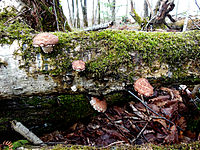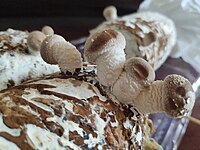Shiitake
| Shiitake | |
|---|---|

| |
| Scientific classification | |
| Domain: | Eukaryota |
| Kingdom: | Fungi |
| Division: | Basidiomycota |
| Class: | Agaricomycetes |
| Order: | Agaricales |
| Family: | Omphalotaceae |
| Genus: | Lentinula |
| Species: | L. edodes
|
| Binomial name | |
| Lentinula edodes | |
| Lentinula edodes | |
|---|---|
| Gills on hymenium | |
| Cap is convex | |
| Hymenium is free | |
| Stipe is bare | |
| Spore print is white to buff | |
| Ecology is saprotrophic | |
| Edibility is choice | |
| Shiitake | ||||||
|---|---|---|---|---|---|---|
| Chinese name | ||||||
Hanyu Pinyin | xiānggū | |||||
| ||||||
| Vietnamese name | ||||||
| Vietnamese | nấm hương | |||||
| Thai name | ||||||
| Thai | เห็ดหอม (hèt hŏm) | |||||
| Korean name | ||||||
| Hangul | 표고 | |||||
| Hanja | 瓢菰 | |||||
| ||||||
| Japanese name | ||||||
| Kanji | 椎茸 or 香蕈 | |||||
| Hiragana | しいたけ | |||||
The shiitake (
Taxonomy
The fungus was first described scientifically as Agaricus edodes by Miles Joseph Berkeley in 1877.[2] It was placed in the genus Lentinula by David Pegler in 1976.[3] The fungus has acquired an extensive synonymy in its taxonomic history:[4]
- Agaricus edodes Berk. (1878)
- Armillaria edodes (Berk.) Sacc. (1887)
- Mastoleucomychelloes edodes (Berk.) Kuntze (1891)
- Cortinellus edodes (Berk.) S.Ito & S.Imai (1938)
- Lentinus edodes (Berk.) Singer (1941)
- Collybia shiitake J.Schröt. (1886)
- Lepiota shiitake (J.Schröt.) Nobuj. Tanaka (1889)
- Cortinellus shiitake (J.Schröt.) Henn. (1899)
- Tricholoma shiitake (J.Schröt.) Lloyd (1918)
- Lentinus shiitake (J.Schröt.) Singer (1936)
- Lentinus tonkinensis Pat. (1890)
- Lentinus mellianus Lohwag (1918)
The mushroom's Japanese name shiitake (椎茸) is composed of shii (椎, Castanopsis), for the tree Castanopsis cuspidata that provides the dead logs on which it is typically cultivated, and take (茸, "mushroom").[5] The specific epithet edodes is the Latin word for "edible".[6]
It is also
Distribution and habitat
Shiitake grow in groups on the decaying wood of
Cultivation
The earliest written record of shiitake cultivation is seen in the Records of Longquan County (龍泉縣志) compiled by He Zhan (何澹) in 1209 during the Song dynasty in China.[8] The 185-word description of shiitake cultivation from that literature was later cross-referenced many times and eventually adapted in a book by a Japanese horticulturist Satō Chūryō (佐藤中陵) in 1796, the first book on shiitake cultivation in Japan.[9] The Japanese cultivated the mushroom by cutting
Shiitake are widely cultivated worldwide, contributing about 25% of the total yearly production of mushrooms.[14] Commercially, shiitake mushrooms are typically grown in conditions similar to their natural environment on either artificial substrate or hardwood logs, such as oak.[13][14][15]
Toxicity
Rarely, consumption of raw or slightly cooked shiitake mushrooms may cause an
Uses
| Nutritional value per 100 g (3.5 oz) | |||||||||||||||||||||||||||||||||||||||||||||||||||||||||||||||||||
|---|---|---|---|---|---|---|---|---|---|---|---|---|---|---|---|---|---|---|---|---|---|---|---|---|---|---|---|---|---|---|---|---|---|---|---|---|---|---|---|---|---|---|---|---|---|---|---|---|---|---|---|---|---|---|---|---|---|---|---|---|---|---|---|---|---|---|---|
| Energy | 141 kJ (34 kcal) | ||||||||||||||||||||||||||||||||||||||||||||||||||||||||||||||||||
6.8 g | |||||||||||||||||||||||||||||||||||||||||||||||||||||||||||||||||||
| Sugars | 2.4 g | ||||||||||||||||||||||||||||||||||||||||||||||||||||||||||||||||||
| Dietary fiber | 2.5 g | ||||||||||||||||||||||||||||||||||||||||||||||||||||||||||||||||||
0.5 g | |||||||||||||||||||||||||||||||||||||||||||||||||||||||||||||||||||
2.2 g | |||||||||||||||||||||||||||||||||||||||||||||||||||||||||||||||||||
Niacin (B3) | 24% 3.88 mg | ||||||||||||||||||||||||||||||||||||||||||||||||||||||||||||||||||
| Pantothenic acid (B5) | 30% 1.5 mg | ||||||||||||||||||||||||||||||||||||||||||||||||||||||||||||||||||
| Vitamin B6 | 17% 0.29 mg | ||||||||||||||||||||||||||||||||||||||||||||||||||||||||||||||||||
| Folate (B9) | 3% 13 μg | ||||||||||||||||||||||||||||||||||||||||||||||||||||||||||||||||||
| Vitamin C | 4% 3.5 mg | ||||||||||||||||||||||||||||||||||||||||||||||||||||||||||||||||||
| Vitamin D | 2% 0.4 μg | ||||||||||||||||||||||||||||||||||||||||||||||||||||||||||||||||||
| Minerals | Quantity %DV† | ||||||||||||||||||||||||||||||||||||||||||||||||||||||||||||||||||
| Calcium | 0% 2 mg | ||||||||||||||||||||||||||||||||||||||||||||||||||||||||||||||||||
| Iron | 2% 0.4 mg | ||||||||||||||||||||||||||||||||||||||||||||||||||||||||||||||||||
| Magnesium | 5% 20 mg | ||||||||||||||||||||||||||||||||||||||||||||||||||||||||||||||||||
| Manganese | 9% 0.2 mg | ||||||||||||||||||||||||||||||||||||||||||||||||||||||||||||||||||
| Phosphorus | 9% 112 mg | ||||||||||||||||||||||||||||||||||||||||||||||||||||||||||||||||||
| Potassium | 10% 304 mg | ||||||||||||||||||||||||||||||||||||||||||||||||||||||||||||||||||
| Sodium | 0% 9 mg | ||||||||||||||||||||||||||||||||||||||||||||||||||||||||||||||||||
| Zinc | 9% 1.0 mg | ||||||||||||||||||||||||||||||||||||||||||||||||||||||||||||||||||
| Other constituents | Quantity | ||||||||||||||||||||||||||||||||||||||||||||||||||||||||||||||||||
| Water | 89.7 g | ||||||||||||||||||||||||||||||||||||||||||||||||||||||||||||||||||
| Selenium | 5.7 ug | ||||||||||||||||||||||||||||||||||||||||||||||||||||||||||||||||||
| †Percentages estimated using simmered dishes. In Chinese cuisine, they are often sautéed in vegetarian dishes such as Buddha's delight .
One type of high-grade shiitake is called donko (冬菇) in Japanese[21] and dōnggū in Chinese, literally "winter mushroom". Another high-grade mushroom is called huāgū (花菇) in Chinese, literally "flower mushroom", which has a flower-like cracking pattern on the mushroom's upper surface. Both of these are produced at lower temperatures.
NutritionIn a 100-gram (3+1⁄2-ounce) reference serving, raw shiitake mushrooms provide 141 kilojoules (34 kilocalories) of dietary minerals .
Like all mushrooms, shiitakes produce Gallery
References
External links
| |||||||||||||||||||||||||||||||||||||||||||||||||||||||||||||||||||






